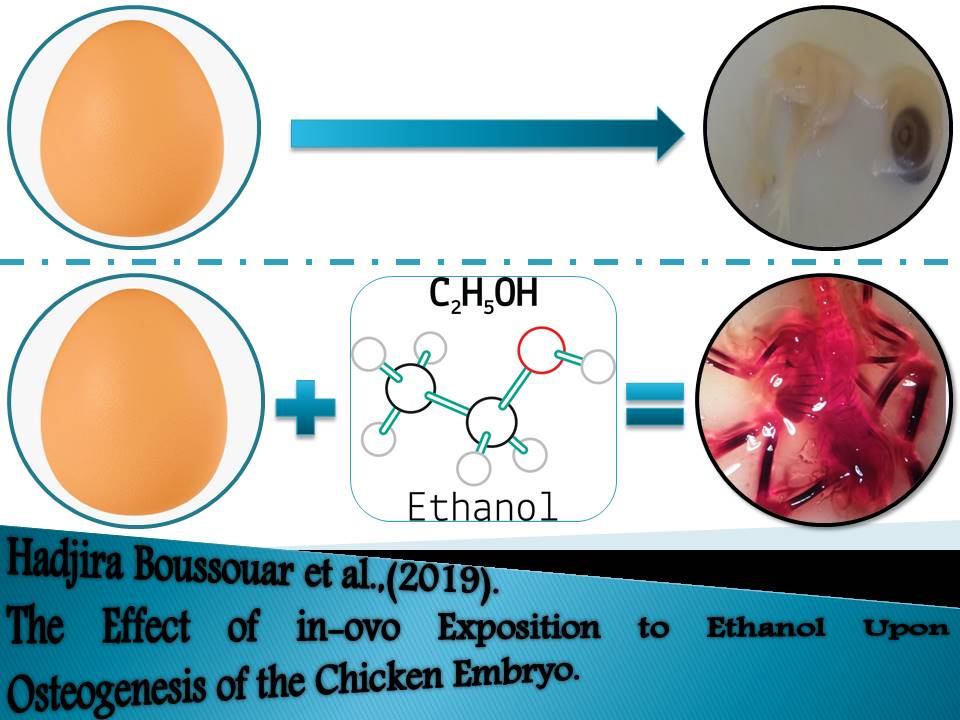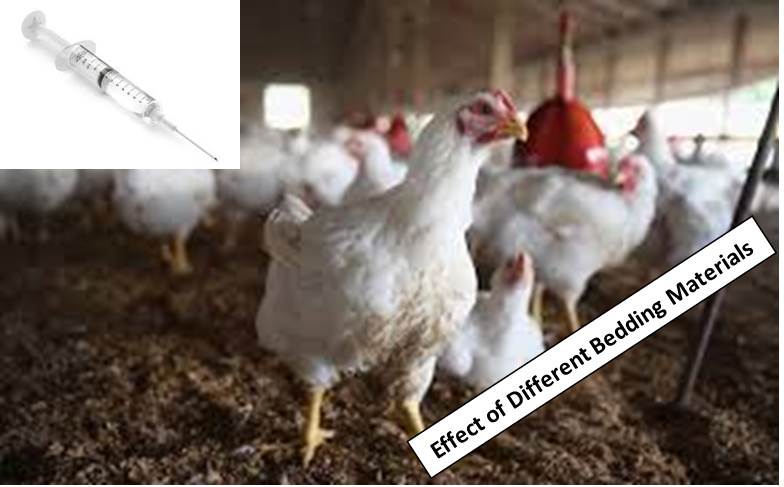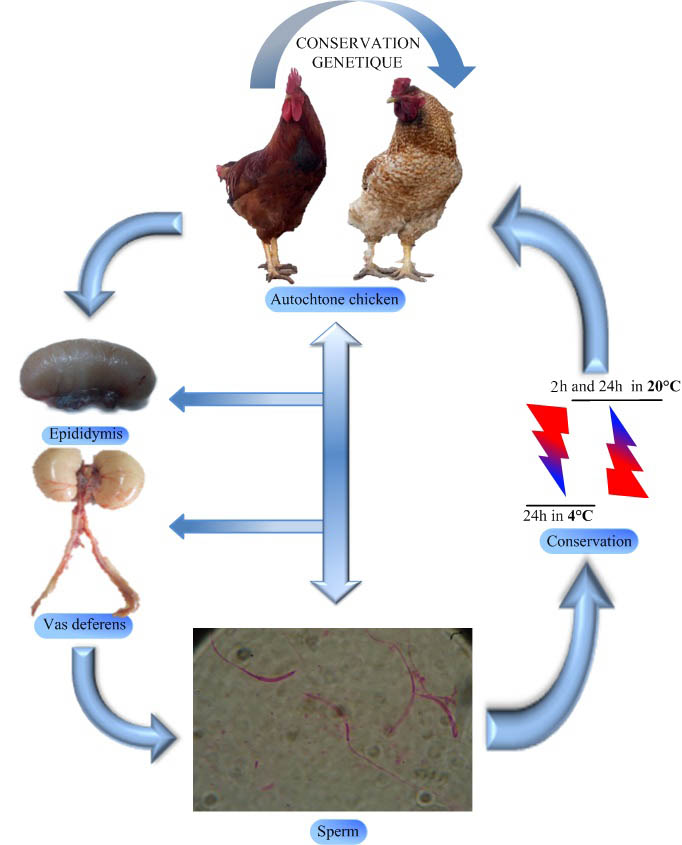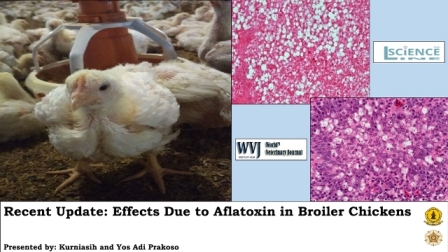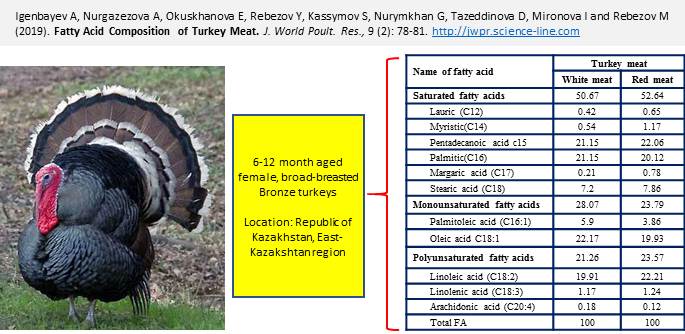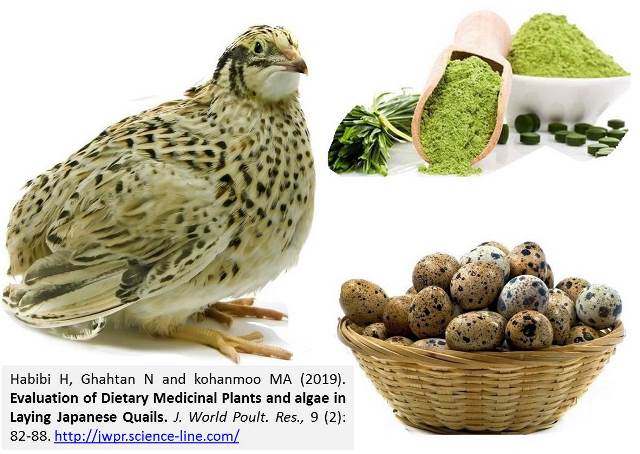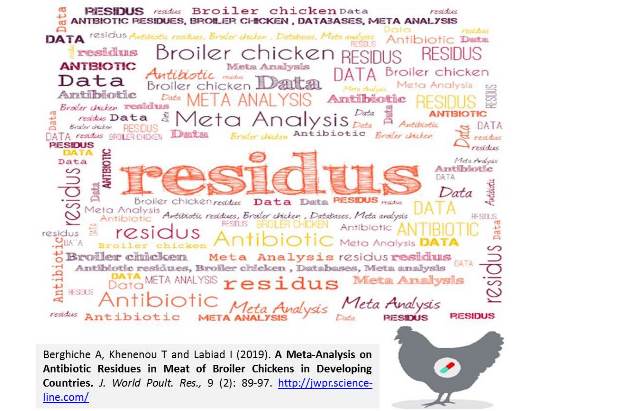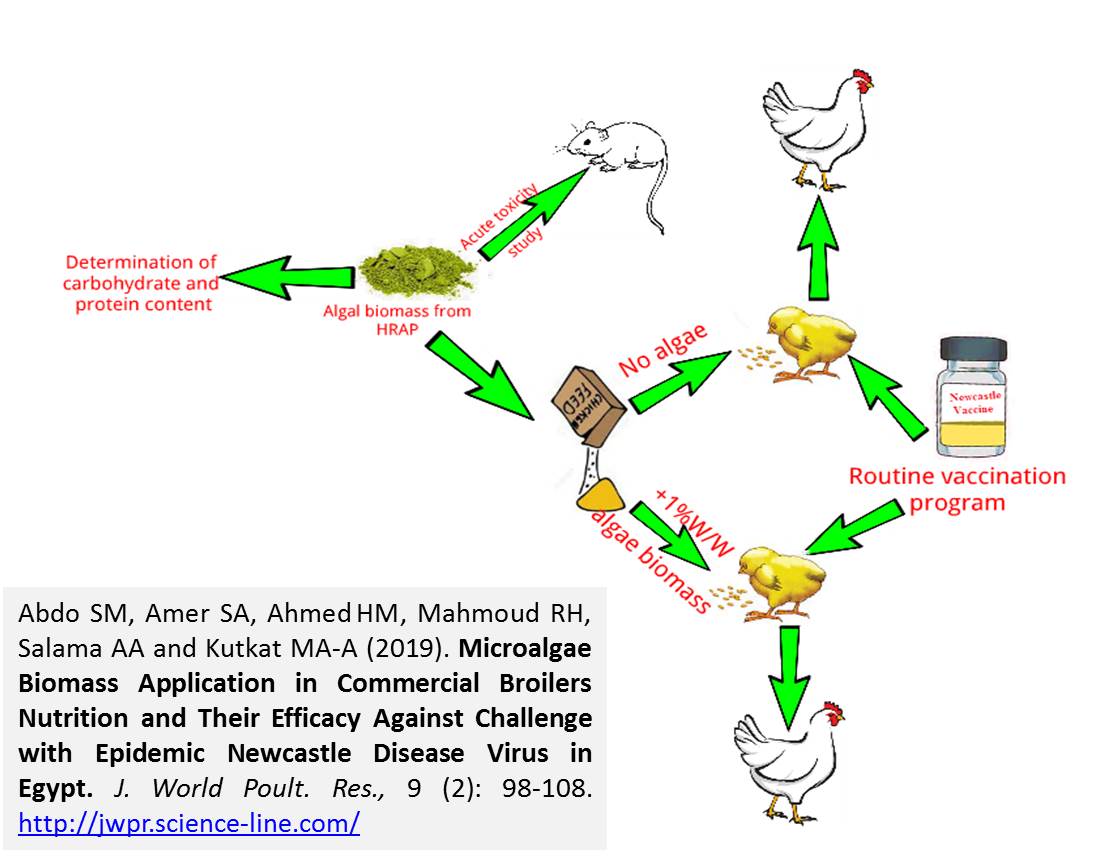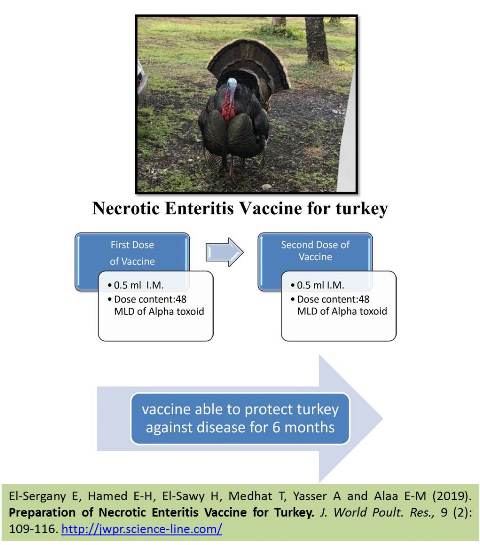Previous issue | Next issue | Archive
![]() Volume 9 (2); June 25, 2019 [Booklet] [EndNote XML for Agris]
Volume 9 (2); June 25, 2019 [Booklet] [EndNote XML for Agris]
The Effect of In Ovo Exposition to Ethanol Upon Osteogenesis of the Chicken Embryo.
Boussouar H, Khenenou T, Bennoune O and Berghiche A.
J. World Poult. Res. 9(2): 32-37; pii: S2322455X1900005-9
DOI: https://dx.doi.org/10.36380/jwpr.2019.4
ABSTRACT
Excessive alcohol consumption by a pregnant woman may delay foetal development and may cause malformations. In this study, the model of the chicken embryo to demonstrate the teratogenic effect of ethanol (33%) on the chicken osteogenesis on the 10th day of embryonic development have been used. 49 fertilized eggs were used in present investigation. Hence, different doses of ethanol were injected into the chicken embryos at 33% (20, 40, 80μl) in the air space at gastrulation and, on the other hand, an equivalent amount of the mentioned doses of distilled water were injected into the control-group eggs which was done once in every two days in order to maintain a high concentration in the blood. Experiments were repeatedly and independently carried out for three times. The eggs were incubated in a humid incubator at the temperature of 37.7 °C and at 60-65% of humidity. On the 10th day of incubation, the embryos were taken out and fixed in formalin at 10%. After that, the eggs were sectioned at 5μm of thickness with a Leica micrtome and, then, stained with the Hematoxylin and eosin. Histological examination has revealed that the exposition of chicken embryos to ethanol (33%) delays the skeletal development in a dose-dependent manner by reducing the length of the cartilaginous proliferation zone and hypertrophic zone during the bone formation period. Furthermore, under the effect of ethanol, the cell proliferation activities were repressed. In conclusion, present results indicated that using ethanol to treat chicken embryos at early stages caused considerable malformations and a decreased in the embryo survival rate. The exposition to alcohol affects the chicken osteogenesis in a dose-dependent manner.
Keywords: Chicken embryo, Ethanol, Malformations, Osteogenesis, Teratogenic effect
[Full text-PDF] [XML] [Crossref Metadata]
Effects of Feeding Different Levels of Baker’s Yeast on Performance and Hematological Parameters in Broiler Chickens.
Mulatu K, Ameha N and Girma M.
J. World Poult. Res. 9(2): 38-49; pii: S2322455X1900006-9
DOI: https://dx.doi.org/10.36380/jwpr.2019.5
ABSTRACT
The effects of feeding baker’s yeast performance of Cobb 500 broilers were studied. Four nearly isocaloric and isonitrogenous starter and finisher rations were prepared. 240 chicks with an average initial body weight of 42g were randomly divided into 12 groups contained 4 treatments with 3 replications for each treatment. Treatment rations were containing 0, 0.5, 1.5 and 2.5% of baker’s yeast as T1, T2, T3 and T4 respectively. At the end of the trial, 3 males and 3 female chickens from each replication were slaughtered for carcass evaluation. The Crude Protein (CP) and Metabolizable Energy (ME) contents of baker’s yeast were 48% and 3615 kcal/kg DM, respectively. The CP content of the rations during the starter and finisher phases were 22% and 20%, respectively. The ME content of the rations during the starter and finisher phases were 3100 kcal/kg and 3200 kcal/kg respectively. Feed intake during the starter phase and entire trial period was lower for T4, whereas during the finisher phase in control diet group showed the highest feed intake than the other supplemental groups. The highest daily body weight gain was recorded in broilers fed T4 rations during starter phase, finisher phase and entire experimental period. Feed conversion ratio of T4 and T3 groups was better than T2 and T1. T3 and T4 groups had higher eviscerated percentages. Blood parameters results showed that fed broilers yeast containing ration had higher WBC, PCV and Hb. Partial budget analysis indicated that the highest net income, marginal rate of return and chicks’ sale to feed cost were obtained for T3 followed by T4. Baker’s yeast can be an important feed additive, which can be included up to 2.5% of the total ration and improve the overall performance of broilers without compromising the hematological indices of broiler chickens.
Keywords: Baker’s yeast, Blood constituents, Broiler, Carcass and Growth
[Full text-PDF] [XML] [Crossref Metadata]
Effect of Different Bedding Materials on the Hematological and Serum Biochemical Parameters of Broiler Chickens.
James G, Garba DJ, Adeolu AS, Adamu Z and Mamma Z.
J. World Poult. Res. 9(2): 50-58; pii: S2322455X1900007-9
DOI: https://dx.doi.org/10.36380/jwpr.2019.6
ABSTRACT
The aim of the present study was to determine the effect of different bedding materials on the, hematological and serum biochemical parameters of the broiler chickens. A completely randomized design was employed for the research in which the treatment were five bedding materials (rice hulls, groundnut hulls, wood shaving, sharp sand and control). The treatments were replicated three times each with ten birds in each experimental unit. The birds were brooded for two weeks before the experiment begin. The blood samples were collected at day 56 of experiment for hematological and serum biochemical analysis. There was no significant difference in the glucose, serum total protein, globulin, calcium, sodium, total bilirubin, conjugated bilirubin, and serum alanine transferase, but there was a significant difference in serum cholesterol, albumin, bicarbonate and serum aspartate transferase within the groups. The findings also indicated in the hematological parameters that bedding materials caused significant difference in the hemoglobin content, white blood cell count and mean corpuscular hemoglobin, but no significant differences in the other parameters (Heterophils, monocytes, basophils, lymphocytes, mean cell volume and packed cell volume) were seen. The results suggested that rice, hulls, groundnut hulls and sharp sand can serve appropriately as bedding materials for broiler production, with compatible effects on serum biochemical and hematological parameters.
Keywords: Bedding materials, Broilers, Hematology, Serum biochemistry
[Full text-PDF] [XML] [Crossref Metadata]
The characterization of Post -Mortem Sperm of Local Chicken Cocks inEastern Algeria.
Ouennes H, Afri Bouzebda F, Bouzebda Z, Majdoub S, Djaout A and Adnane Smadi M.
J. World Poult. Res. 9(2): 59-67; pii: S2322455X1900008-9
DOI: https://dx.doi.org/10.36380/jwpr.2019.7
ABSTRACT
The present aimed to investigate for the first time the characteristics and conservation of post-mortem sperm, obtained from epididymis and the vas deferens of 18 pairs of adult local chicken cocks from the east of Algeria (age, 12-24 months, body weight 1.50-2.53 kg). And compare the sperm quality at the epididymis and the vas deferens levels, the efficacy of two post-mortem sperm retrieval techniques, the flushing and float-out methods in the collection of local chicken cock’s sperm, and the effects of conservation in situ at different temperatures (2h and 24h at 20°C and after refrigeration at 4°C for 24h). The quality was significantly higher (0.13±0.05ml vs 0.72±0.12ml) in the vas deferens compared to the epididymis, whereas spermatozoa abnormalities and chromatin quality did not differ in both the epididymis and vas deferens. No significant difference was observed between the flushing and float-out methods. Concentration (3.33±1.63 million sperm vs 1.75±0.76 million sperm), initial motility (77.50±6.89% vs 75.83±8.61%), viability (75±10.39% vs 74.67±10.15%) and abnormality (30.33±4.68% vs 30.33±4.68%), only the volume was significantly higher (0.72±0.12ml vs 0.17±0.08ml). However, the effects of conservation in situ, at 25°C and 4°C for 24h, showed a significant difference for viability and motility of the spermatozoa recovered from vas deferens, and no significant difference for abnormality and acrosome integrity. Therefore, it can be concluded that good quality semen samples can be collected from the vas deferens with the flushing method, and semen of Algerian local cocks can be preserved at 20°C for 24h.
Keywords: Conservation, Eastern Algeria, Epididymis, Local cocks, Post-mortem, Vas deferens
[Full text-PDF] [XML] [Crossref Metadata]
Recent Update: Effects of Aflatoxin in Broiler Chickens.
Kurniasih and Prakoso YA.
J. World Poult. Res. 9(2): 68-77; pii: S2322455X1900009-9
DOI: https://dx.doi.org/10.36380/jwpr.2019.8
ABSTRACT
Aflatoxin is a worldwide problem in poultry industries as it is known to contaminate poultry feed. Aflatoxin induces stress and increases mortality rate during infection in poultry, especially broiler chickens. The objectives of this study was to observe the pathological effects due to aflatoxicosis in broiler chickens. A total of 120 chickens were divided into four groups, group A fed with a basal diet without aflatoxin contamination, group B with aflatoxin (> 1 ppb 51 ppb 101 ppb < 150 ppb). The data were collected and analysed on day 7, 14, and 21. The results showed that diet with high aflatoxin contamination in group D impaired the physical and laboratory performances of the chickens, increased the risk of residue in the poultry’s final products. The varying doses of aflatoxin contamination in the chicken feed causes the problems on the broiler chickens with different level of severity.
Keywords: Aflatoxin, Antibody, Broiler, Haematology, Immunohistochemistry, Residue
[Full text-PDF] [XML] [Crossref Metadata]
Fatty Acid Composition of Female Turkey Muscles in Kazakhstan
Igenbayev A, Nurgazezova A, Okuskhanova E, Rebezov Y, Kassymov S, Nurymkhan G, Tazeddinova D, Mironova I and Rebezov M.
J. World Poult. Res. 9(2): 78-81; pii: S2322455X1900010-9
DOI: https://dx.doi.org/10.36380/jwpr.2019.9
ABSTRACT
This paper aimed to study the fatty acid composition of turkey meat. Red and white turkey meat were sampled from the local markets of Semey city, republic of Kazakhstan. The proximate composition showed a significant difference in the fat content of red and white meat. The fatty acid composition of turkey meat was as follows: saturated fatty acids 50.67% in white and 52.64% in red meat; monounsaturated fatty acids 28.07% in white and 23.79% in red meat; polyunsaturated fatty acids 21.26% in white and 23.57% in red meat. Palmitic and pentadecanoic are the major saturated fatty acids, where the oleic and linoleic acids are in a large amount in monounsaturated and polyunsaturated fatty acids, respectively.
Keywords: Fatty acid, Polyunsaturated fatty acid, Red meat, Turkey meat, White meat
[Full text-PDF] [XML] [Crossref Metadata]
Evaluation of Dietary Medicinal Plants and algae in Laying Japanese Quails.
Habibi H, Ghahtan N and kohanmoo MA.
J. World Poult. Res. 9(2): 82-88; pii: S2322455X1900011-9
DOI: https://dx.doi.org/10.36380/jwpr.2019.10
ABSTRACT
The current study was conducted to examine the influences of Sargassam cristafolium, Gracilaria pulvinata, Rhus coriaria, and Punica granatum peel dried powder in two levels (10 and 20gr/kg) of dietary on productive performance and some egg quality characteristics of laying Japanese quail. A total of 675 (49 days old) Japanese quail were randomly distributed into nine groups with three replicates of 25 birds in each. Results showed that egg weight, shell weight, albumen weight and shell thickness were not influenced by treatments. The effects of medicinal plants on weekly egg production differ depending on the dietary medicinal plant type and dosage. Moreover, the birds fed diet supplemented with Sargassum cristaefolium at 10g/kg had greater weekly egg production compared to others. Haugh unit was reduced by diet supplemented with R. coriaria. Diet supplemented with S. cristaefolium at 20 g/kg increased yolk weight. Furthermore, greater albumen protein and thiobarbituric acid content of the tenth day’s eggs (TBAd10) were perceived in birds fed diet supplemented with G. pulvinata. In present study, the lowest levels of cholesterol (9.66 mg/g) was determined in the egg yolk of groups R. coriaria and G. pulvinata, and the control group showed to have the most amounts (12.00 mg/g). Based on obtained data, addition of 0.5% and 2% of S. cristafolium, G. pulvinata, R. coriaria, and P. granatum peel to the diet lead to be progress in egg production rate, enhanced the egg quality and egg biochemical properties in Japanese quail.
Keywords: Egg production, Egg quality, Laying quails, Medicinal plants, Thiobarbituric acid
[Full text-PDF] [XML] [Crossref Metadata]
A Meta-Analysis on Antibiotic Residues in Meat of Broiler Chickens in Developing Countries.
Berghiche A, Khenenou T and Labiad I.
J. World Poult. Res. 9(2): 89-97; pii: S2322455X1900012-9
DOI: https://dx.doi.org/10.36380/jwpr.2019.11
ABSTRACT
Present study consisted of performing a meta-analysis on data about the detection of antibiotic residues in chicken meat achieved from all over the researches with a wide collection and very strict selection criteria of data. The databases were searched quantitative inputs from the available scientific publications using important keywords, in order to evaluate all studies about antibiotic residue and detection methods and the reliability of the results obtained by the international researchers. Then an advanced statistical analysis on collected data was done, the first phase was a descriptive study of positive and negative cases followed by a modeling of two cases with a prediction of the values obtained and ended with an analysis of the main compounds (population size, residue detection methods and positive case rates). All performed steps are reported in detail. The results indicated that the accuracy of the detection technique is a factor that influenced on reports of residues, and caused differences in reports, there are still antibiotic residues in meat of intensively broiler chicken farms (45. 26% of the samples analysed are positive), It is concluded that residue detection requires a high-precision qualitative analysis protocol.
Keywords: Antibiotic residues, Broiler chicken, Databases, Meta-analysis.
[Full text-PDF] [XML] [Crossref Metadata]
Microalgae Biomass Application in Commercial Broilers Nutrition and Their Efficacy Against Challenge with Epidemic Newcastle Disease Virus in Egypt.
Abdo SM, Amer SA, Ahmed HM, Mahmoud RH, Salama AA and Kutkat MA-A.
J. World Poult. Res. 9(2): 98-108; pii: S2322455X1900013-9
DOI: https://dx.doi.org/10.36380/jwpr.2019.12
ABSTRACT
Using microalgal biomass in animal diets has been studied recently. Many species of cultivated algae were found effective in maintaining animal growth performance, and in improving body weight. Using of microalgae collected from high rate algal ponds (HRAP) as a feed additive to broilers ration was studied. One hundred and twenty broiler chicks were divided into 6 groups of 20 birds, three of them have fed on balanced broiler ration supplied with 1% weight per weight (W/W) of microalgae biomass and have variable vaccination schemes of live attenuated and inactivated Newcastle disease virus (NDV) vaccines genotype II or either non-vaccinated control. In addition, the other 3 groups have fed on free microalgae biomass balanced ration with the same vaccination treatment. Furthermore, weight gain, antibody response, mortalities, viral shedding and normal viability of chickens were estimated in order to assess the efficiency of microalgae as a feed additive. The results showed that the microalgae have no hazard effect on feed and water intake as well as enhanced viability of chickens. And in regards to immune function and body weight, they have similar effect with the free microalgae groups in normal serological response and viral shedding post vaccination with NDV vaccines as well as similar protection rate and body weight gain. In conclusion, microalgae can be used in broiler ration with no deleterious effect on growth rate, weight gain, poultry viability and immune response. In conclusion dried microalgal biomass harvested from HRAP can be used in broiler ration with no deleterious effect on growth rate, weight gain, poultry viability and immune response. Furthermore, future studies should be applied with increasing microalgae percent in poultry feed up to 5, 10 or 20% (W/W) in order to assess better performance on poultry production.
Keywords: Algae biomass, Immune response, Newcastle disease virus, Poultry feed
[Full text-PDF] [XML] [Crossref Metadata]
Preparation of Necrotic Enteritis Vaccine for Turkey.
El-Sergany E, Hamed E-H, El-Sawy H, Medhat T, Yasser A and Alaa E-M.
J. World Poult. Res. 9(2): 109-116; pii: S2322455X1900014-9
DOI: https://dx.doi.org/10.36380/jwpr.2019.13
ABSTRACT
Clostridium perfringens is the most important cause of enteritis in domestic animals, in chicken and turkey it well known as pathogen responsible for necrotic enteritis; hepatitis, and cholecystitis. The disease in turkey characterize by either severe form with high rate of mortalities or subclinical form of reduce growth rate and increase condemnation rate. The major factor responsible for pathogenicity of Clostridium perfringens was alpha toxin. The aim of present study was to prepare of Clostridium perfringens alpha Toxoid vaccine for controlling the necrotic enteritis disease. The vaccine was prepared at different doses depend on lethality of toxin (24, 48 and 96 Minimum Lethal Dose) for controlling necrotic enteritis disease. Antibody titer elicited by vaccination was measured by toxin neutralization test, ELISA, and challenge test. It revealed that antibody titer expressed by international antitoxin unit per ml was 7.4, 4.1 and 1.26 respectively according to the mentioned dose, and also the protection percent against challenge was 100% when vaccinated with either 48 or 96 Minimum Lethal Dose, while it gave 80% when vaccinated with 24 Minimum Lethal Dose.It concluded that use of Clostridium perfringens alpha Toxoid with recommended dose of 48 MLD able to protect turkey for 6 months.
Keywords:Alpha toxin, Clostridium perfringens, Turkey, Type A, Vaccine
[Full text-PDF] [XML] [Crossref Metadata]
Previous issue | Next issue | Archive
![]() This work is licensed under a Creative Commons Attribution 4.0 International License (CC BY 4.0).
This work is licensed under a Creative Commons Attribution 4.0 International License (CC BY 4.0).

